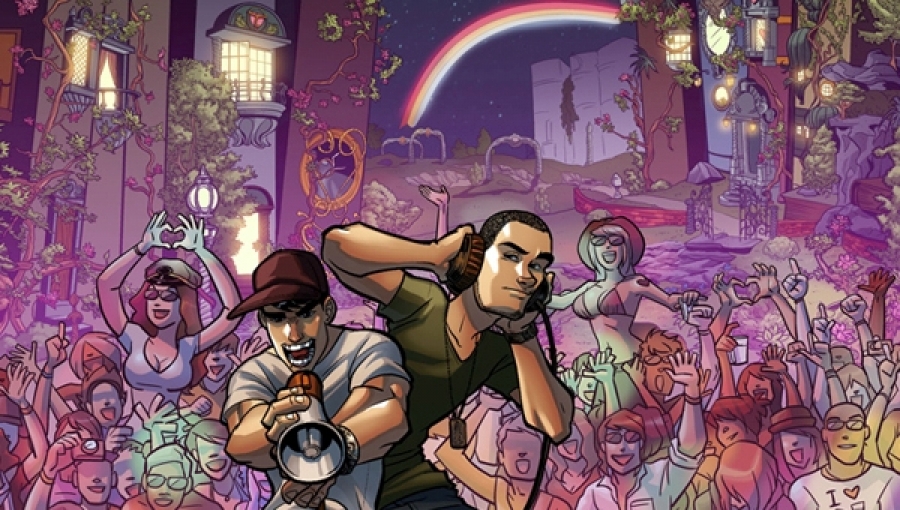Tomorrowland is not a graphic novel; it is an experience. Before reading this graphic novel, I was unaware of the famous Tomorrowland Festival in Belgium. Writer Paul Jenkins does an excellent job of not only creating an original story incorporating the belief systems, people, and imagery from the actual festival, but he also helps to educate the reader about the festival itself, enticing them to learn more and become a fan if not already one. After reading this graphic novel, I am eager to someday attend Tomorrowland in Belgium and its sister festival, Tomorrowworld, that just opened in September of 2013 in Chattahoochee Hills (near Atlanta, Georgia). Jenkins has created a mythology to enhance the experiences of patrons attending the annual world famous Tomorrowland Festival, as well as novices such as myself. It’s a fun and beautiful graphic novel and a brilliant marketing strategy!
Stellar Labs does a magnificent job of capturing the feel of the Tomorrowland Festival World through their artwork. The Festival’s logo (Tomorrowland in Tibetan Script underneath a pink third eye chakra symbol) is used for the cover title along with background imagery from actual festival sets. DJs Dimitri Vegas and Like Mike (famous Dj’s synonymous with the festival and the graphic novel’s lead characters) are depicted with life-like precision, as are the historical figures in the story, such as William Shakespeare. The colors used are vibrant and bold with the festival’s logo color, pink, emanating throughout. A wide palate of colors are used; however, colors seem to pop off the page in the scenes where the forces of creation and destruction are present. Bright fuchsias, fiery reds, and icy blues all work with the drawings to create a fantastical, unworldly feel. Imam E. Wibowo effortlessly translates the festival’s logo font into the text for chapter titles. I would have liked to see that font also used in dialogue and action text. This graphic novel, like the festival, does not follow convention when it comes to graphic blocks. Every page is set up differently to match the action and the mood of the story with the blocks varying in size and shape. The images and text bubbles often overlap the boxes, keeping the momentum flowing. It is as if you are reading the storyboard for a movie that wants to break barriers and seep off the page into our world.
The phrase “Yesterday is History, Today a Gift, Tomorrow is Mystery” is part of Tomorrowland Festival’s logo and the theme behind Paul Jenkins’ mythology for the graphic novel. In his story, the festival Tomorrowland is the location of a yearly epic battle between The Unnamed One (Fear/Destruction) and Creativity. Throughout time the world has had many kinds of “Tomorrowlands,” and each year a single person is chosen as the keeper of “Tomorrowland,” to wage battle and defeat the powers that work to stifle and ultimately destroy creativity; however, in this story, for the first time there are two keepers (Dimitri Vegas and Like Mike) instead of one. Like Mike is used by the Unnamed One in an attempt to break up the duo and destroy Tomorrowland. “All men are two men” (Robert Stevenson) and carry both destruction and creation inside of themselves. The festival, and this graphic novel, look to inspire creativity in the world and challenge humanity to continue to fight the urge for materialism and power.
At times, the plot and mythology can come across a tad saccharine and hippy dippy, making Tomorrowland feel as if it should belong amongst self-help and spiritual healing books. But, once I accepted and embraced that style, I thoroughly enjoyed the story. A lot of graphic novels struggle with story; this is not one of those cases. In fact, story is so important that there are times when exposition becomes verbose and unnecessary. I could have done with a little less handholding by the author and more action. It felt like most of the time was spent setting up, explaining, and reminding the reader of the mythology, leading to less action and stunting the existing action. I was left wishing the story flowed as well as the artwork. That being said, I loved that such a detailed mythology was created around an actual festival, and that the history of the fictional characters, along with the actual people and images from past festivals, were included at the end of the graphic novel. In fact, patrons of future festivals will be able to see aspects of the graphic novel incorporated in set pieces, themes, and novelties at the festival. All of this detail/research helped this graphic novel to become a psychedelic experience, not just another read. I look forward to future additions and hope to someday attend the festival to see the graphic novel come to life!

